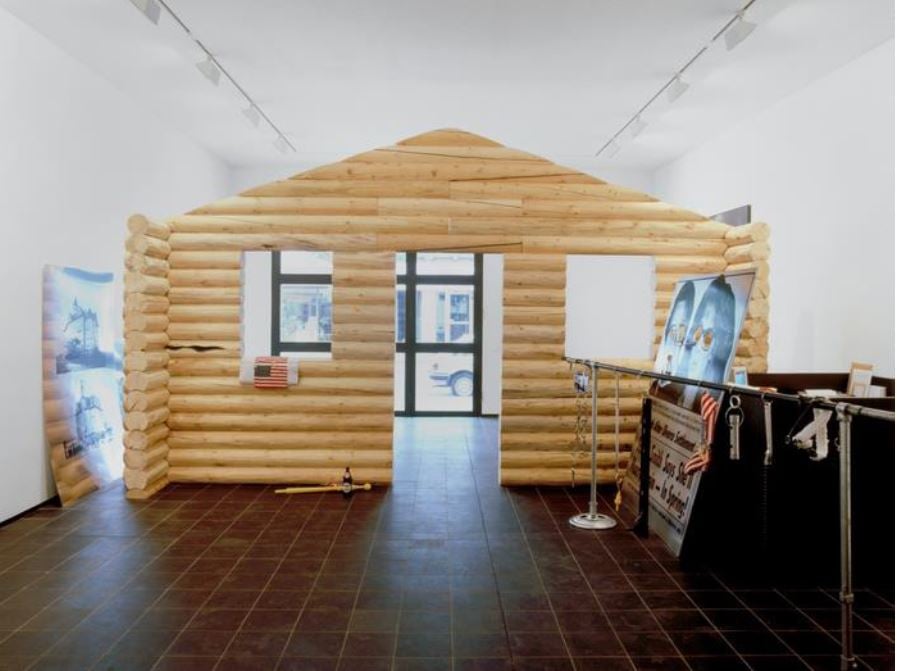Law & Politics
Cady Noland Sues Three Galleries for Copyright Infringement Over Disavowed Log Cabin Sculpture
The artist claims that dealers have profited off of a "reproduction" of her original work.

The artist claims that dealers have profited off of a "reproduction" of her original work.

Julia Halperin &
Eileen Kinsella

How much can you conserve an artwork before it becomes something entirely different?
This question is at the heart of a lawsuit filed in New York earlier this week by the artist Cady Noland. She claims that a collector and a group of dealers infringed her copyright by hiring a conservator to repair her sculpture Log Cabin (1990) without consulting her. The repair, Noland says, went way beyond the bounds of normal conservation.
“This is not a restoration—this is a copy,” Noland’s lawyer Andrew Epstein told artnet News. By discarding the rotting logs and wooden elements that made up the cabin’s facade and replacing them with new ones, the conservator essentially destroyed the original work and created an unauthorized reproduction, according to the lawsuit.
“Wood can be restored, even rotting wood,” Epstein said. “This is a forgery.”
Noland is suing the collector Wilhelm Schurmann, who bought Log Cabin soon after it was made; KOW Gallery of Berlin, which displayed the work in a 2011 exhibition; art advisor and dealer Chris D’Amelio; Galerie Michael Janssen and Janssen himself, who sold Log Cabin to an Ohio collector in 2014. Noland says that some, if not all, members of this group were involved in the decision to refabricate the work in 2010.
In addition to copyright infringement, Noland claims that her rights were violated under New York’s often-referenced but rarely litigated Visual Artist Rights Act (VARA), which allows visual artists to disown their work under certain circumstances, including when works have been restored due to “gross negligence” on the part of the owner.
Noland says that the collector who loaned Log Cabin to a German museum was “either negligent or indifferent to the work” and “failed…to protect the work from rot, deterioration and exposure to the elements.” (Log Cabin was on view from 1995 to 2005 in an outdoor courtyard at the Suermondt-Ludwig-Museum in Aachen.)
This is not the first time Log Cabin has been the subject of a dispute. In 2014, after she was alerted to the wood replacement, Noland—who has a history of disowning works—faxed a handwritten letter to the Ohio collector who had recently bought it, stating, “This is not an artwork” and objecting to the fact that it was repaired by a conservator “BUT THE ARTIST WASN’T CONSULTED.”
(The collector, Scott Mueller, later sued both Galerie Michael Janssen and art advisor Marisa Newman, who helped facilitate the $1.4 million sale; the lawsuit was dismissed in December.)
Why did Noland file her own lawsuit now? Epstein notes that the artist first became aware that Log Cabin had been copied on July 18, 2014. The lawsuit was filed exactly three years later, on July 18, 2017—just barely within the three-year statute of limitations for bringing a claim of copyright infringement.
Noland has asked for Log Cabin to be destroyed, and for the court to block the defendants from distributing any images of the work. She is also seeking all profits earned by the galleries and their agents from the infringement of her copyright, as well as damages.
In an e-mailed statement to artnet News, Janssen said: “I have not been served with any lawsuit, but based on what I have heard I believe that it has no merit. Unfortunately, Ms. Noland has a history of trying to use the law to hurt art collectors and even her own artwork. That should not be necessary and I hope to find a positive outcome in this case.”
D’Amelio and a representative from KOW did not immediately respond to requests for comment. Schurmann could not be reached for comment.